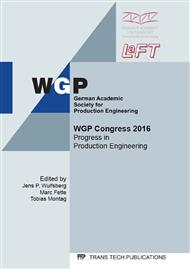p.141
p.149
p.157
p.165
p.173
p.181
p.189
p.197
p.205
Simulation Based Reduction of the Impact Load Occurring in the Moment of Cutting Edge Entrance in Order to Prolong Tool-Life
Abstract:
High mechanical impact loads in interrupted or inhomogeneous machining processes frequently lead to spontaneous fracture of the cutting edge. Even modern cutting materials cannot provide a combination of high enough hardness and toughness that is capable of preventing this sort of tool failure. Such machining conditions therefore remain difficult and further investigations, aiming to reduce the impact load of the cutting tool in order to enhance tool-life, are necessary. A simulation model of the impact situation, that serves to optimize a force conducting structure with regard to elasticity, damping properties and resulting force peaks, was developed and is presented in this paper. Furthermore measurement devices were composed that are needed for high-resolution recording of impact forces without repercussions and for verification of the elaborated simulation model. It could be shown that mechanical damping of the cutting tool can lead to reduced impact forces on the cutting edge, which in turn should lead to longer tool life.
Info:
Periodical:
Pages:
173-180
Citation:
Online since:
August 2016
Authors:
Keywords:
Price:
Сopyright:
© 2016 Trans Tech Publications Ltd. All Rights Reserved
Share:
Citation:


